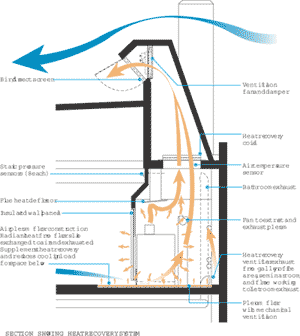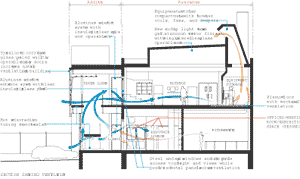Specifying Ceilings: From Classic to Curved
The design team added a two-story, steel-framed entry along the original east wall. Its first floor is sheathed with aluminum-framed clear glass and its second with salvaged translucent-corrugated-glass panels and aluminum battens. This public zone looks out onto a landscaped pervious courtyard paved with crushed limestone that doubles as a parking lot. From this entry, one can access the new program spaces located within the shell of the old brick building: flameworking studio, seminar room, exhibition space, and offices on the first floor; hot, technical, casting, and coldworking shops on the second floor.
The glass-making process centers on the hot shop, where two 1,000-pound glass furnaces, eight glory holes, and several electric annealers line up along the west wall. Turning a problem into an opportunity, the architects took advantage of this heat-intensive equipment to create a mechanical system for the building that is as energy efficient as possible.
|
Relying largely on convection, the architects use the heat of the glass furnaces to activate a natural ventilation system throughout most of the building. Extending beyond the roofline above the zone of equipment is a 100-foot-long hood assembly. It is segmented so that each compartment functions as a distinct vertical flue through which heat rises. Openings at the top are oriented so that the exhaust from the building will flow out in sync with the region's prevailing wind currents. Ventilation fans at the top of the hoods are activated as needed by sensors to supplement the convective exhaust system.
The stale air exiting the hot-shop chimneys draws replacement air from unconditioned spaces on the first and second floors. These areas, in turn, pull fresh air from the outdoors via a variety of operable windows and vents. To permit this uninhibited flow of air through multiple spaces in a mixed-use building, the architects needed a building variance that would allow them to treat much of the building as an atriumlike space. The design team had to provide a sufficient number of sprinkler heads, specify fire-alarm sensors, and develop equipment-shut-off protocols, for example, in order to forego fire dampers, ducted return systems, and 2-hour-rated doors and partitions at critical transition points.
There were some exceptions to this unimpeded flow of air. Certain areas were mechanically isolated either because the activities they supported, such as welding, plaster-mold making, and sandblasting, generated unhealthy particulates or because they needed to be more fully conditioned to meet standard expectations, such as the offices, classrooms, and gallery. For additional energy savings, heat-recovery coils were installed within the hood assembly to transfer all waste heat to a liquid medium that is then circulated to radiant floors and air-handlers in other parts of the center.











